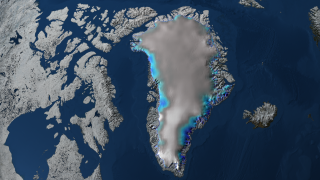Why the Greenland and Antarctic Ice Sheets are Not Collapsing
Global warming alarmists have suggested that the ice sheets of Greenland and Antarctica may collapse, causing disastrous sea level rise.Sunday, August 30th 2009, 7:44 am
Why the Greenland and Antarctic Ice Sheets are Not Collapsing
27 08 2009
Image: NASA Goddard Spaceflight Center SVS
Cliff Ollier
School of Earth and Geographical Sciences, The University of
Western Australia, Crawley, WA 6009, Australia.
Colin Pain
Canberra City ACT 2601, Australia.
Global warming alarmists have suggested that the ice sheets of Greenland and Antarctica may collapse, causing disastrous sea level rise. This idea is based on the concept of an ice sheet sliding down an inclined plane on a base lubricated by meltwater, which is itself increasing because of global warming.
In reality the Greenland and Antarctic ice sheets occupy deep basins, and cannot slide down a plane. Furthermore glacial flow depends on stress (including the important yield stress) as well as temperature, and much of the ice sheets are well below melting point.
The accumulation of kilometres of undisturbed ice in cores in Greenland and Antarctica (the same ones that are sometimes used to fuel ideas of global warming) show hundreds of thousands of years of accumulation with no melting or flow. Except around the edges, ice sheets flow at the base, and depend on geothermal heat, not the climate at the surface. It is impossible for the Greenland and Antarctic ice sheets to ‘collapse'.
In these days of alarmist warnings about climate warming, the ice sheets of Greenland and Antarctica have an important role. Many papers have described their melting at the present times, and dire predictions of many metres of sea level rise are common. Christoffersen and Hambrey published a typical paper on the Greenland ice sheet in Geology Today in May, 2006.
Their model, unfortunately, includes neither the main form of the Greenland Ice Sheet, nor an understanding of how glaciers flow. They predict the behaviour of the Ice Sheet based on melting and accumulation rates at the present day, and the concept of an ice sheet sliding down an inclined plane on a base lubricated by meltwater, which is itself increasing because of global warming. The same misconception is present in textbooks such as The Great Ice Age (2000) by R.C.L. Wilson and others, popular magazines such as the June 2007 issue of National Geographic, and other scientific articles such as Bamber et al. (2007), which can be regarded as a typical modelling contribution. The idea of a glacier sliding downhill on a base lubricated by meltwater seemed a good idea when first presented by de Saussure in 1779, but a lot has been learned since then.
In the present paper we shall try to show how the mechanism of glacier flow differs from this simple model, and why it is impossible for the Greenland and Antarctic Ice Sheets to collapse. To understand the relationship between global warming and the breakdown of ice sheets it is necessary to know how ice sheets really work. Ice sheets do not simply grow and melt in response to average global temperature. Anyone with this naïve view would have difficulty in explaining why glaciation has been present in the southern hemisphere for
More Like This
August 30th, 2009
March 22nd, 2024
March 14th, 2024
February 9th, 2024
Top Headlines
April 24th, 2024
April 24th, 2024










